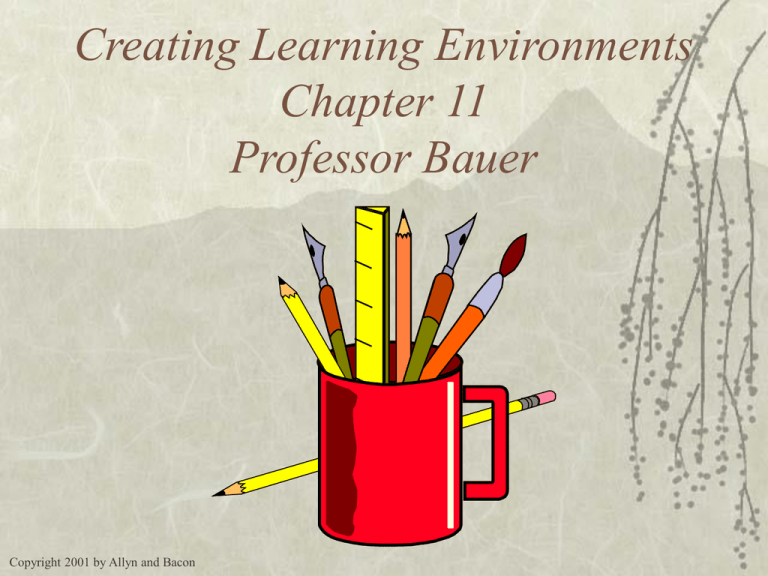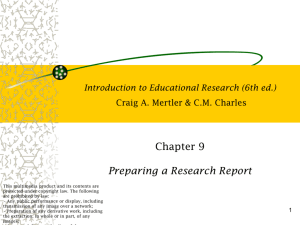PowerPoint Presentation - Classroom Management Chapter 11
advertisement

Creating Learning Environments Chapter 11 Professor Bauer Copyright 2001 by Allyn and Bacon Overview The Need for Organization Creating a Positive Learning Environment Creating a Learning Community Maintaining a Good Environment for Learning The Need for Communication Copyright 2001 by Allyn and Bacon Concept Map for Chapter 12 The Need for Communication Need for Organization Creating Learning Environments Maintaining a Good Environment for Learning Copyright 2001 by Allyn and Bacon Creating a Learning Community Creating a Positive Learning Environment The Need for Organization Copyright 2001 by Allyn and Bacon Ecology of Classrooms Characteristics of Classrooms: – – – – – – Multidimensional Simultaneous Immediate Unpredictable Public Histories Copyright 2001 by Allyn and Bacon Basic Management Task Gain & maintain cooperation Motivate & engage Adjust management to ages of students Copyright 2001 by Allyn and Bacon Age Related Needs Early elementary: teach rules & procedures Middle elementary: monitor & maintain Late elementary & beginning high school: – Diplomatically deal with defiance – Motivate those immersed in social life Senior high school: – Manage curriculum – Adapt academics to student needs & interests – Teach self-management Copyright 2001 by Allyn and Bacon Goals for Classroom Management Time for learning – Allocated time – Engaged time or time on task – Academic learning time Access to learning Participation structures Self-management Copyright 2001 by Allyn and Bacon Where Does the Time Go? Academic Learning Time Engaged Time Actual Academic Time Attended Time Total Time 0 Copyright 2001 by Allyn and Bacon 200 400 600 800 1000 1200 Hours Creating a Positive Learning Environment Copyright 2001 by Allyn and Bacon Strategies from Research Rules and procedures are required Plan spaces for learning Plan for effective classroom management Get off to a good start Copyright 2001 by Allyn and Bacon Classroom Procedures Administrative routines Student movement Housekeeping Lesson routines Teacher-student interactions Student-student interactions See Guidelines, Woolfolk, p. 441 Copyright 2001 by Allyn and Bacon Rules for Making Rules Do’s and don’ts Often written down and posted Set the atmosphere Consistent with school rules Consistent with principles of learning Make a few, good rules Copyright 2001 by Allyn and Bacon Rules for Elementary School Be polite and helpful Respect other’s property Listen when others are speaking Do not hit, shove, or hurt others Obey school rules Copyright 2001 by Allyn and Bacon Rules for Secondary School Bring required materials to class Seated and ready at the bell Respect and be polite to everyone Respect other people’s property Sit and listen while others speak Obey all school rules Copyright 2001 by Allyn and Bacon Consequences of Breaking Rules Plan ahead “Bill of Rights” Reasons for appropriate behavior Self-management Penalties See Table 12.1, Woolfolk, p. 443, and Table 12.2, p. 444 Copyright 2001 by Allyn and Bacon Categories of Penalties Express disappointment Lose privileges Exclude from group Write a reflection Detention Visit the principal’s office Contact parents Copyright 2001 by Allyn and Bacon Planning Spaces for Learning Interest areas Personal territories Action zone Seating arrangements See Guidelines, Woolfolk, p. 446 Copyright 2001 by Allyn and Bacon Room Arrangements Be aware of the action zone Horizontal rows: whole group presentations Clusters or circle: student interaction Fishbowl or stack: close up demonstrations Copyright 2001 by Allyn and Bacon Getting Started : Elementary First day well planned & organized Deal with student’s main concerns Teach rules & procedures Whole group focus Appeal to student interests Monitor the whole group Stop misbehavior quickly Copyright 2001 by Allyn and Bacon Getting Started : Secondary Establish rules, procedures, and standards Clearly communicate standards for work Consistently enforce expectations Monitor students closely Deal with rule infractions quickly Shorter work cycles for lower ability students Monitor student progress carefully Copyright 2001 by Allyn and Bacon Creating a Learning Community Copyright 2001 by Allyn and Bacon Three ‘C’s’ of Classroom Management Cooperative community Constructive conflict resolution Civic values See Table 12.3, Woolfolk, p. 450 Copyright 2001 by Allyn and Bacon Maintaining a Good Environment for Learning Copyright 2001 by Allyn and Bacon Maintaining a Good Environment for Learning Busy students are better behaved Supervise students closely Include cues for desired behaviors Clear steps for activities Provide necessary materials Engage students in authentic tasks Employ curiosity, interest Copyright 2001 by Allyn and Bacon Prevention Is the Best Medicine Withitness Overlapping Group focus Movement management Monitor!!! Copyright 2001 by Allyn and Bacon Dealing with Discipline Problems Make eye contact Verbal hints : name dropping Ask students if they are aware of the consequences of their behavior Remind students of the relative rule or procedure Ask the student to state the correct rule or procedure and follow it Assertively tell the student to stop the misbehavior Offer a choice Copyright 2001 by Allyn and Bacon Special Problems with Secondary Students Work not completed: – – – – Teach students how to use a daily planner Keep accurate records Enforce established consequences Do not grade on ‘the benefit of the doubt’ Continue to break rules: – – – – Seat student away from other students Catch them before they break the rules Enforce established consequences Don’t accept promises Copyright 2001 by Allyn and Bacon Special Problems: Hostile Behaviors Get out of the situation as soon as possible Give the student the choice to cooperate Allow a short cool down period Talk privately in the hall Send another student for the assistant principal Conference with a counselor, parents, other teachers Keep a record of the incident Copyright 2001 by Allyn and Bacon Special Problems: Violence or Destruction of Property Send for help Get the names of all participants Disperse any crowd Do NOT try to break up a fight without help Inform the school office of the incident Follow the school policy Copyright 2001 by Allyn and Bacon The Need for Communication Copyright 2001 by Allyn and Bacon Message Sent = Message Received? Hidden messages Body language Choice of words Paraphrase rule Copyright 2001 by Allyn and Bacon Who’s Problem Is It? Does this affect my role as teacher? Student owned: actively listen Teacher owned: problem solve Copyright 2001 by Allyn and Bacon Counseling: The Student’s Problem Empathetic listening – Block out external stimuli – Listen carefully – Differentiate between intellectual and emotional messages – Make inferences about the speaker’s feelings Copyright 2001 by Allyn and Bacon Confrontation and Assertive Discipline Use of “I” messages Passive or hostile responses Care enough to confront Clearly stated expectations with eye contact Do not debate ‘fairness’ of the rules Expect changes - not promises or excuses See Point▼Counterpoint, Woolfolk, p. 461 Copyright 2001 by Allyn and Bacon Confrontation and Negotiation Teacher imposes a solution Teacher gives in to student demands Gordon’s “no-lose method” – – – – – – Define the problem Generate many possible solutions Evaluate each solution Make a decision on a solution Determine how to implement the solution Evaluate the success of the solution Remember IDEAL? See Woolfolk, pp. 290-296. Copyright 2001 by Allyn and Bacon Student Conflicts and Confrontations Conflicts: goals and needs clash Violence – Prevention is the best cure – High academic expectations – Genuine care for students Mentoring, peer mediation, conflict resolution, social skills, relevance, community involvement programs Copyright 2001 by Allyn and Bacon Steps in Peer Mediation Jointly define conflict Exchange positions and interests Reverse perspectives Invent 3 arguments that allow mutual gain Reach an integrative agreement Copyright 2001 by Allyn and Bacon Respect & Protect Program Respect & protect the rights of others Violence is not acceptable Target violence-enabling behaviors Clearly define violence – Bully/victim violence – Normal conflict violence Adult-centered and student-centered interventions See Table 12.5, Woolfolk, p. 465 Copyright 2001 by Allyn and Bacon Families and Classroom Management Parents as partners Clear classroom expectations Communicate See Family & Community Partnerships, Woolfolk, p. 466 Copyright 2001 by Allyn and Bacon Management Scenarios Copyright 2001 by Allyn and Bacon Reflection Questions Consider the following scenarios. Decide what you would do in each situation. Don’t stop with an initial response to the situation. Come up with a ‘Plan B’ just in case ‘Plan A’ would not work. Consider multiple perspectives for each scenario. Copyright 2001 by Allyn and Bacon Elementary: Art Kent, Kari, and Krista are working together on an art project. Kent needs the tangerine crayon to finish the trim on an Indian blanket. Kari really needs the tangerine crayon to touch up the sunset. Krista really REALLY needs the tangerine crayon to do the tree leaves. A major conflict is about to erupt! How will you use this as a learning opportunity to teach the concept ‘sharing’? Copyright 2001 by Allyn and Bacon Elementary: Cheating It is achievement test time, and you have consistently encouraged your students to do their own best work. However, during the reading comprehension test, you notice that Melissa is exhibiting ‘severe diagonal vision disorder’ (cheating). At least two other students have noticed, also! What prescription would you recommend to treat her malady? Copyright 2001 by Allyn and Bacon Secondary: Defiance You have just handed back the exam results. Sean is NOT one of your outstanding students, and is not happy with his grade. You ask, “Sean, do you have any questions on the exam?” His retort challenges the validity of your test, compares your IQ to your shoe size, states his opinion about your heritage, and suggests a place for you to take an extended vacation. Sean uses descriptive language and explicit adjectives. Your response? Copyright 2001 by Allyn and Bacon Secondary: Vandalism On a crisp, September morning, you go to school early. As you enter the building, you notice a white haze in the halls, but no smell of smoke. Suddenly you hear glass breaking and see three students with fire extinguishers burst out of the chemistry lab, spraying white every where, running toward you. Next? Copyright 2001 by Allyn and Bacon Back Stage It is after school on a nice day in May. You have to make copies of a test for your class tomorrow morning. You decide to take a shortcut to the teachers’ workroom through the back of the stage. You hear unusual but intriguing sounds coming from a dim corner of the stage and decide to investigate. You discover two students engaged in active and intimate physical contact. Now what? Copyright 2001 by Allyn and Bacon Reflection Time Copyright 2001 by Allyn and Bacon Summary The Need for Organization Creating a Positive Learning Environment Creating a Learning Community Maintaining a Good Environment for Learning The Need for Communication Copyright 2001 by Allyn and Bacon Review Questions What are the challenges of classroom management? What are the goals of good classroom management? Distinguish between rule and procedures. Distinguish between personal territories and interest-area spatial arrangements. Copyright 2001 by Allyn and Bacon Review Questions Contrast the first school week of effective and ineffective managers. What are Johnson and Johnson’s three C’s of establishing a classroom community? How can teachers encourage engagement? Explain the factors identified by Kounin that prevent management problems in the classroom. Copyright 2001 by Allyn and Bacon Review Questions Describe seven levels of intervention in misbehavior. What is meant by “empathetic listening”? Distinguish among assertive, passive, and hostile response styles. What are some options for dealing with student-student and student-teacher conflicts? Copyright 2001 by Allyn and Bacon End Chapter 12 Copyright 2001 by Allyn and Bacon




